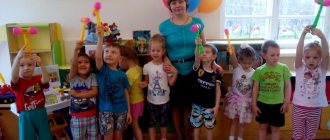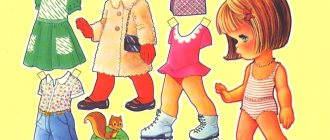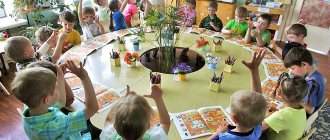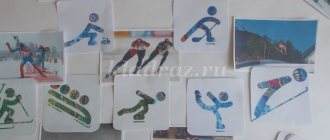Summary of a didactic game for younger preschoolers (3-4 years old)
Didactic game about animals for children of the younger group of kindergarten
Didactic game with elements of conversation about wild animals “Guess the riddle”
Author: Yulia Alekseevna Gorchakova, teacher at the Irdanovsky kindergarten “Kolosok”, Nikolsky district, Vologda region. Description of material: This game is designed for children of primary preschool age, and can also be useful for teachers, educators and parents who want to teach their kids to solve riddles. Goal: learning to solve riddles about wild animals using illustrations of them. Objectives: - continue to introduce children to wild animals of their native land (hare, wolf, bear, fox, squirrel, hedgehog); — teach children to identify and name the distinctive features of wild animals; - stimulate the cognitive interest of children, promote the development of memory, attention, and intelligence; — to cultivate a humane and caring attitude and love for animals. Equipment: illustrations depicting wild animals. Introduction: We, parents and teachers, are often surprised that a child cannot answer a simple question and finds it difficult to guess the simplest riddles. You should not rush to tell your child the answer. It is much more useful if the child independently understands the content and meaning of the riddle and learns to relate some object to the content. If parents quickly offer their child their answer, he will simply lose interest in the game. In solving riddles, the most important thing is to look for the answer; it is the search that teaches the child to think and compare. Teachers and psychologists suggest that we begin learning to solve riddles from the age of three. We, educators, suggest parents start with the simplest thing: with simple questions (“Where are the bunny’s ears?”, “What does the cat say?” and so on). These questions can be asked starting from a very young age. From the age of 2, you can use rhyming riddles in games, where the answer just begs to be answered. Let these be riddles that draw the child’s attention to simple, well-known objects: toys, animals, food, household items. Try to choose riddles that name color, shape, size, habits. To help your child, prepare illustrations for viewing, among which the child will see the answer. Progress of the game: - Guys, look what we have on the table? (Children approach the table on which the pictures are laid out.)
- That's right, these are pictures.
Who is depicted on them? (Wolf, fox, bear, squirrel, hare, hedgehog).
- How can you call them in one word?
(These are animals. Wild animals).
- Let's play with these pictures?
I will ask you a riddle, and you will show me the answer - a picture. Agreed? Listen carefully to the first riddle. 1. “A ball of fluff, Long ear, Jumps deftly, Loves carrots.” Who is this? That's right, bunny. (Show picture).
How did you guess?
(Children name the signs by which they recognized the animal). Looking at an illustration of a hare. - What kind of fur coat does the bunny have? (Soft, white, fluffy, warm).
— In winter the bunny is white, and in summer it is gray.
-Where does the hare live? (Under a bush).
-What does he like to eat?
(Grass, bark, carrots, cabbage).
- How can you affectionately call a hare?
(Bunny, bunny, bunny).
2. At night he howls in the forest: “I’ll carry the lamb away!”
The angry, hungry gray one also knows a lot about hares... (Wolf)
Who is this?
This is a wolf. (Show picture).
How did you guess?
Looking at an illustration of a wolf.
- What kind of fur coat does he have? (Gray, thick).
-What does a wolf eat?
(Catches mice, birds, hares).
— What is the name of his house?
(Lair)
- How can you affectionately call a wolf?
(Little wolf, little wolf, little wolf).
3. He sleeps in a den in winter, quietly snores, and when he wakes up, well, roar, what is his name?
- … (Bear)
Looking at an illustration of a bear. - What kind of fur coat does the bear have? (Thick, warm, brown).
— What is the name of the bear's house?
(Den).
—What does a bear eat?
(Eats berries, honey, sweet roots, fish)
- What does a bear do in winter?
(Sleeping).
- And why?
(In winter there is no food for him; it is difficult for him to walk through the snowdrifts).
- How can you affectionately call a bear?
(Teddy bear, little bear, little bear).
4.Jumps from branch to branch, but rarely comes down to the ground.
The small, fragile body always wears a fur coat. The claws on the paws are sharp: It’s not easy to run up the trunk! This red-haired one flies through the branches like an arrow... (Squirrel)
This is a squirrel.
(Show picture).
Looking at an illustration of a squirrel. -What is she like, little squirrel? (Red-haired, fluffy, agile)
-Where does the squirrel live?
(In a hollow, on a tree).
— What does a squirrel eat?
(Berries, mushrooms, cone seeds, nuts).
- What is a gentle name for a squirrel?
(Squirrel, little squirrel).
5. Guess another riddle.
Red-haired cheat, cunning head. The fluffy tail is beauty, and her name is... (fox).
Look how it is - It’s all burning like gold.
He walks around in an expensive fur coat, his tail is fluffy and large. Looking at an illustration of a fox. -What is she like? (Red-haired, fluffy, cunning).
- Where does he live, what does he eat?
(Lives in a hole, eats mice, birds, bunnies).
- What is a gentle name for a fox?
(Fox, little fox, little fox).
6. He runs along a forest path, carries a mushroom home on his back.
If you don't stroke it, you won't take it. Did you guess it? This is... (Hedgehog)
- That's right, this is a hedgehog.
Looking at an illustration of a hedgehog. - What is he like, a hedgehog? (Small, prickly).
— What does a hedgehog eat?
(Insects, bugs, midges, sometimes fruits and mushrooms. They say that the hedgehog loves to eat apples, in fact, he cleans his needles from parasites with sour apple juice).
— What does a hedgehog do in winter?
(Sleeping).
- What can you affectionately call a hedgehog?
(Hedgehog, hedgehog). Reflection.
— Who did we solve riddles about today? (About wild animals).
— What animals live in the forest?
— Did you like our game with pictures? You are so smart, you solved all the riddles! Which riddle did you like best? What animal? Parents are given creative homework: draw the wild animal that the child remembers most after the game. Result: creative project - exhibition “Wild Animals”.
We recommend watching:
Didactic game for the younger group of kindergarten Didactic game for children 3-4 years old “Vegetable garden” Do-it-yourself didactic manual for kindergarten Do-it-yourself didactic game for the younger group “Gather beads on a string”
Similar articles:
Didactic game for children of the second junior group
Didactic game for the younger group of kindergarten “Colorful dishes”
Summary of the didactic game in the 2nd junior group in the direction of “Physical Education”
Summary of a didactic game in the educational field “Physical Education”. "Wonderful bag." Second junior group.
Goal: To teach children the correct use of sports equipment in the physical education and health center using the game “Wonderful Bag”.
Objectives: To give children an idea of the types of sports equipment and their purpose. Cultivate attention and the ability to use previously acquired knowledge. Develop dexterity, coordination of movements, eye. Develop children's speech.
Material: Beautiful bag, skipping rope, ball for knocking down pins; throwing bag, ribbon, su-jok, medicine ball.
Educator: Come on guys, look how many guests have come to see you and how you can play. The guests grew up and forgot how to play. Do you know how to play?
Children: Yes.
Educator: Look, someone else is waiting for us, it’s... that’s right Kolobok! Hello Kolobok!
Kolobok: I came to visit you and brought this “Wonderful bag”, it contains objects, but I don’t know what they are called and what they are needed for.
Educator: Guys, what should we do?
Children: We need to help Kolobok.
Educator: Do you know how to do this?
Children: No
Educator: Now we will take out these items one by one, name them and say what they are needed for, and we will help Kolobok. Kolobok, guys, sit down.
Game "Wonderful bag".
Educator: Come Artem, stick your hand in and take out the object.
The child takes out a jump rope.
Educator: What is this?
Child: Jump rope
Educator: What is it for?
Child: To jump.
Educator: Well done, sit down. Diana, come and get it. The child comes up and takes out a ball for knocking down the pins.
Educator: What is this?
Child: Ball.
Educator: why is it needed?
Child: To knock down pins.
Educator: Guys, do you know what this game is called, in which pins are knocked down with a ball?
Children: Boling...
Educator: That's right, "Bowling." Come to me, I have a bucket of balls here, take it apart, stand one after another, we’ll play “Bowling.”
Children come up, take apart the balls, and stand one after another. They start playing bowling. Kolobok and the teacher praise all the children and invite them to sit on chairs and play “Wonderful Bag” further.
Educator: Come Marusya, get it. The child takes out a ribbon (non-standard equipment for foot correction.)
Educator: What is this and why is it needed?
Child: This is a ribbon, it lies on the floor and you need to take it with your toes.
Educator: Well done Mashenka, that’s right. We grab this ribbon with our toes and strengthen the muscles of the foot, but why do we do this?
Children: So that our legs don’t hurt, and we can jump and run.
Educator: Well done. Sit down Marusya, come Maksimka, get it. The child takes out Su Jok. The teacher repeats his question and listens to the child’s answer.
Child: Jock.
Educator: Su Jok will be correct. Su - hand, Jock - foot. What are we doing to them?
Child: We massage our hands.
The teacher invites the children to come up and take Su Joki from the box and massage their hands. Children disassemble Su Joki and sit on chairs. The teacher reads the poem:
I roll the ball in circles, (Children roll the massager in a circular motion.)
I drive him back and forth. (Roll the ball with straight movements).
I will stroke their palm. (Take it with your fingers and stroke your palm.)
It's like I'm sweeping away crumbs
And I’ll squeeze it a little, (Make a squeezing movement.)
How a cat squeezes its paw
I will press the ball with each finger (Press the fingers, starting with the thumb).
And I'll start with the other hand.
After the massage, everything is put away in the box and another child is invited to come up and get the next item. The child takes out a bag of cereal (non-standard equipment).
Educator: What is this and why is it needed?
Child: Bag. We put it on our head and walk with it, making the arms to the sides.
Educator: Well done, that's right, we put this bag of cereal on our head, spread our arms to the sides, straighten our shoulders, straighten our back and stand or walk. Why are we doing all this?
Children: To avoid being hunchbacked and to avoid back pain.
Educator: Well done! Shall we show Kolobok how to use the bag? Come up, take the bags, put them on your head and walk around, try not to let the bag fall. Children take the bags apart and perform actions with them. After which the teacher praises them and Kolobok, offers to put the bags on the table and see if all the objects have been taken out of the bag. Invites the child to come up and get another item. The child takes out a medicine ball (non-standard equipment), and the teacher repeats the question.
Child: This is a ball, we do exercises with it.
Educator: When do we do exercises and why?
Children: In the morning, we strengthen the body.
Educator: Well done, now come to the table. What's on the table?
Children list all the items taken from the bag. The teacher generalizes that all these items are sports equipment and the place of all these items is in the “Center for Physical Education and Health.”
Educator: Guys, Kolobok also wants to get something out of the bag.
Kolobok takes out a mask for the outdoor game “Shaggy Dog” and asks the children what it is and why it is needed.
Children: This is worn on the head when playing the game Shaggy Dog.
Kolobok: I want to learn how to play this game, teach me guys.
The children agree. The teacher suggests going outside and everyone playing together.
Title: Summary of the didactic game in the direction of “Physical Education”. Nomination: Educational games/Didactic Author: Druzhinina Svetlana Vladimirovna Position: teacher of the first qualification category Place of work: MADOU Child Development Center Kindergarten No. 11 Location: Perm region, Dobryanka st. Engels
Modified date: 11/29/2015 Published date: 11/29/2015







